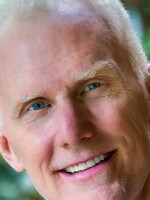Just after dawn, Monte Markley gears up on his farm near Augusta, in southern Kansas. He pulls on a special hunting vest and camouflage cap.
"This is a bull-riding glove," Markley says, tugging on a bright yellow glove that he uses as a falconing gauntlet.
Murmuring softly, he rouses his new raptor from her perch. "Come on, wake up, there you go," Markley says, coaxing a female prairie falcon named Storm onto his fist. He trapped her in the wild a few months ago and he's been training her ever since, slowly building trust and loyalty.
Markley, whose gray hair is visible under his camouflage cap, says he fell in love with raptors as a kid.
Like a lot of children of his generation, he read the classic novel My Side of the Mountain by Jean Craighead George, about a boy who lives in the wild with a falcon. He dreamed of having a bird of his own, and then one day he got his chance.
"A local farmer came by one day, I was probably 12, and he had a hawk in a box," Markley says. The bird had fallen out of a tree nest. "My mother drove me into the Augusta public library, and I got the one falconry book that they had and figured out how to keep this bird alive."
He hunted with that first raptor for three years and was hooked. Decades later, he's rated a master falconer.

Will she stay or will she go?
Storm, his latest raptor, is beautiful in a dangerous way. She's his only bird right now.
As Markley prepares for their training hunt, she wears a leather hood over her head and eyes to keep her calm.
She's a born hunter. Her coloration is perfect camouflage. Her wings are the color of dry grass and tree bark. The delicate feathers on her chest are cream-white. Her curved beak and talons are like polished blades.
When falcons strike their prey, Markley says, they punch them with their feet or hit them with their breast bone.
At this stage of Storm's bonding process, each flight is an experiment. It's not a sure thing she'll come back. "There's birds I thought I had it all dialed in," he says, shaking his head. "They take off, you never see it again. It's over, just that fast."
Markley, who's in his fifties now, is my cousin, though we haven't seen each other since we were little boys.
When he heard I was visiting Kansas, he invited me to join him and Storm. He loads her into his pickup truck, and we set out on winding country roads looking for a good place to fly.

Building trust one flight at a time
The day is cold and windswept and the Kansas horizon looks incredibly remote.
Markley says the process of building a bond with a wild raptor is delicate. At first, the birds are furious and terrified. "The first few hours to three days are pandemonium," he says. "Then once they eat that first meal [out of your hand] they start building a little trust. Then by day three or four, they're jumping on your fist for food."
We park the pickup and set off across a stubbled field. There's a frozen pond in the distance. Clouds scud across the vast pearl blue sky.

It's a nervous moment as Markley slips off Storm's hood and releases the jesses that tie her to his glove.
"Hey girl," he says softly. Then he gestures gently sending her up into the wind. Storm shrieks and climbs fast. "She's probably 400 or 500 feet right now," Markley says.
He lets her prowl the sky for a bit, then releases a domestic pheasant for her to hunt. This is the test — will Storm hunt with Markley or fly away?
He runs forward across the field, calling out to direct the falcon toward the prey. Storm responds, darting down out of the sky. There's a quick strike, a violent tussle on the ground and the pheasant falls dead.

This time it works, Storm decides to stay. After a little coaxing by Markley, she settles and waits for us, perched patiently on her prey.
"You know, there's really no tether other than that trust," Markley says.
A raptor that escapes from a falconer just goes back to being wild. It happens all the time, Markley says.
But he's clearly relieved. He sits next to Storm in the grass grinning as she shrieks. "You're a fuss-bucket this morning," Markley says fondly, rewarding her with little bits of pheasant meat.
If their bonding continues and deepens, Markley and Storm will be together for a long time, hunting the Kansas plains for a decade or more.
Copyright 2025 NPR





